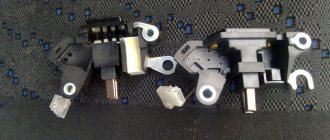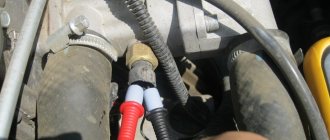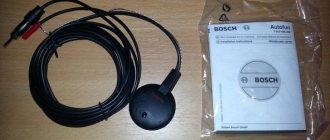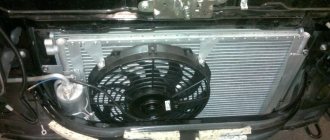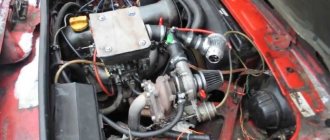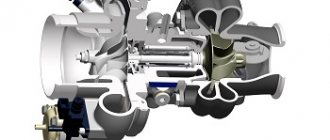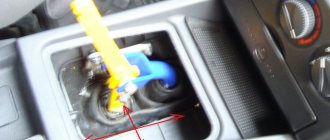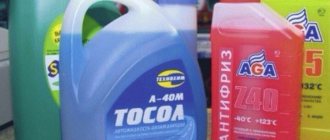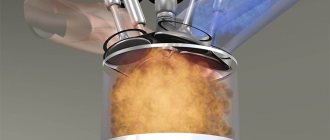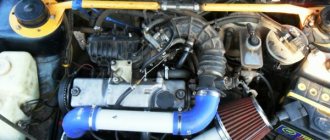The number of cars produced with turbocharged engines is constantly growing, as such cars are in demand in the market. However, not all car owners know how a turbine on a gasoline engine works, although they show interest in this topic. The point here is not laziness at all, but an overly complex presentation of the material, making it inaccessible to understanding for most motorists.
First you need to understand what a turbine is for : it allows you to increase the power of a small engine without harming it and without increasing fuel consumption. But there are certain operating features, the observance of which will make it possible to increase efficiency and extend the total operating time of the power unit.
At what speed does the turbine “turn on” (turbo boost)
Many drivers are convinced that the turbine turns on only at high speeds, since at low speeds they do not feel the effect of turbocharging on movement. This is a half-truth - in fact, the turbine on the car works constantly, but at low speeds the discharge is weak. Let's take a closer look at it:
- When the engine operates at up to 1500-2000 rpm, the exhaust gases create only a slight pressure on the turbine blades. Therefore, a small amount of oxygen is pumped into the internal combustion chamber, so the driver does not feel an increase in power. This phenomenon is called turbo lag.
- As power increases above 2000 rpm, exhaust gases begin to affect the turbines, which leads to a noticeable injection of oxygen into the internal combustion engine. The relationship here is directly proportional - the higher the speed, the stronger the turbocharging will work and vice versa. This phenomenon is called turbo boost.
Note! Many turbines are equipped with a safety valve that blocks operation of the device at very high speeds (red zone of the tachometer). This is done so as not to damage the engine.
Turbocharging device
The turbine of a gasoline consists of the following elements :
- Bearing housing housing a rotor with a shaft and rings with blades. As they rotate, they redirect air into the cylinders.
- Channels running through the entire body. Their function is to deliver oil to rotating and rubbing elements, which helps to increase their service life.
- Sleeve bearing guarantees smooth operation of the rotor, lubricated and cooled by oil.
- A casing shaped somewhat like a snail, protecting the component elements of the mechanism from mechanical damage.
Why the turbine may not turn on - malfunctions
When driving a car with a turbocharging system, the driver may encounter many problems and malfunctions. Let's look at the main problems and methods for solving them:
- Safety valve malfunction . It happens that the valve becomes clogged with debris or cracks, which leads to blocking the operation of the turbine. It is quite simple to establish a breakdown - up to approximately 3-4 thousand revolutions, the valve can still work, so it will pump air. However, if this indicator is exceeded, it abruptly closes the turbine, which leads to a drop in power. To solve the problem, turn off the car's electronic systems, open the hood, disconnect the negative terminal from the battery, find the turbine, turn off the lubrication system and remove the device (usually it is located next to the engine). Then remove the valve and inspect it, if necessary, clean the device or replace it.
- Leaky fastening of turbocharging components . To ensure maximum air injection power into the internal combustion engine, it is necessary that the turbine parts are hermetically attached to the vehicle. In the case of a leaky fastening, the pumping power drops sharply. The presence of a problem can be determined by two signs - a sharp decrease in power and the appearance of a characteristic whistle while the car is running. To deal with the problem, you need to turn off the power to the car, open the hood and check the tightness of the device. Problems may arise with the fitting, oil supply pipe, valve, and so on. To fix the problem, you need to restore the tightness (for example, if the problem is in the fitting, you need to buy a new one).
- Using bad oil . For the turbocharging system to operate effectively, the device must be lubricated with oil. However, it happens that the driver uses cheap, low-quality oil with a lot of impurities for lubrication - in this case, the efficiency of turbocharging will significantly decrease. It is very easy to identify the problem - while the car is moving, a sharp loud grinding noise appears in the car, and the engine power does not increase when accelerating to high speeds. The solution to the problem is to buy new high-quality oil and pour it into the car instead of the old one.
What is turbojam or turbolag?
The principle of operation of turbocharging is that the engine “accelerates” itself due to its own work. This feature causes a problem such as turbo lag or turbo lag. It manifests itself in the form of a drop in power that appears after sharply pressing the gas pedal.
At the dawn of turbocharged engines, things got ridiculous - by pressing the gas pedal too sharply and too hard, you could completely turn off the engine. Nowadays, complex mechanical and electronic components will prevent this from happening, but the effect of turbo lag with an unpleasant loss of power still remains. This especially affects cheap turbo systems or those that are incorrectly installed and configured.
To smooth out turbo lag, they use clever electronic systems for proactively increasing speed. They register sharp presses on the accelerator pedal and spin the compressor using electric drives, without waiting for the turbine to “wake up”. The price of such solutions is usually quite high, so they are found mainly only on sports cars.
Myths about turbocharging in the engine
There are many myths among drivers about the operation of the turbocharging system. Let's look at the main stereotypes and find out why they are false:
| Myth 1 – the turbocharging system can be removed at any time without negative consequences | The design and volumes of the internal combustion engine chamber are adapted to the use of the turbine. If you dismantle this device, the torque and power of the engine decreases, and fuel consumption increases |
| Myth 2 – turbocharged engines break down much more often than naturally aspirated ones | Turbine engines have the same shelf life as conventional naturally aspirated engines. To reduce the risk of engine cracking at high speeds, they are additionally reinforced with metal sheets in problem areas |
| Myth 3 – the turbine quickly fails and will have to be replaced frequently | According to modern standards, the shelf life of a turbine is similar to or even slightly longer than the shelf life of the internal combustion engine itself. If you follow basic driving and maintenance rules, the turbo will last as long as the car itself. |
| Myth 4 – the turbine needs special careful care so that it does not break. | For turbocharging to work for a long time, it will be enough to adhere to the basic rules of car operation. Namely - change the oil on time, monitor the pressure level in the engine (do not bring it to the red line), troubleshoot problems in a timely manner |
In fact, the turbine always works, but at low speeds the air injection level will be low due to turbo boost.
Let's summarize. A turbine (turbocharging) is an auxiliary element of the engine, with the help of which air is forced into the internal combustion chamber of the engine. The device starts immediately after activating the engine, but the rule is that the higher the speed, the greater the boost (at low speeds the boost is almost imperceptible). The main problems with the turbine are valve failure, leaky fastening of spare parts, and the use of low-quality oil.
The principle of operation of turbocharging
The operating principle of turbocharging is quite simple. The exhaust gases emitted by the engine enter the turbine and cause it to rotate. The turbine, in turn, transmits torque to the compressor, which sucks in air and compresses it. The compressed air is then directed into the engine cylinders. Optionally, an intercooler (intercooler) is added to this circuit. It reduces the temperature of the air compressed by the compressor, correspondingly reducing its volume. This eliminates unpleasant effects such as detonation, and increases the overall efficiency of the system.
The meaning of pumping in additional air becomes clear if we recall the principle of operation of an internal combustion engine. The fuel-air mixture burns in its cylinders; this process pushes the piston, which turns the crankshaft. But, for efficient combustion of the mixture, it is important to maintain the correct ratio of fuel and air, so you cannot increase power simply by adding more fuel to the mixture. Along with increasing the amount of fuel, the amount of air must also be increased.
This can be done by increasing the volume of the cylinder so that more air can fit into it. But you can go the other way - increase the density of the air driven into the cylinders. Then you can extract significantly more power from the same unit of engine displacement. A good example is sports cars, where each liter of volume can produce more than 150 hp. Of course, in addition to turbocharging, they use a lot of tricks. But it’s quite possible to get 105-115 hp. per liter using turbocharging alone.
The principle of operation of a turbine on a gasoline engine
08-10-2017
An article on the topic of how a turbine operates on a gasoline engine, the operating principle of a variable geometry turbine. The principle of operation of the turbine for Volkswagen, VAZ, Opel Astra J and Opel Insignia.
How does a turbine work on a car? The principle of operation of a turbine on a gasoline engine Volkswagen, VAZ, Opel Astra J, Opel Insignia, Audi A4, Skoda Octavia.
What is a turbocharger - turbine
A turbocharger is a unit whose purpose is to provide high pressure of gases passing through the piston system to increase the power of the car. This improves the car's dynamics during acceleration without increasing the cylinder displacement.
Fuel consumption also remains at the same level. There are two types of turbocharged compressor.
The first, installed on low-power power plants, has a centrifugal type of rotation of the exhaust gas flow. In the second, these gases move along an axial trajectory. The radius of the compressor wheel for passenger cars is 25 mm.
How does a turbine work on a car?
The compressor is driven into rotation using the kinetic energy of the exhaust masses. The outside of the turbine housing is snail-shaped. When entering it, the exhaust gases move through special channels until they come into contact with the surface of the turbine wheel blades.
With this help, this wheel picks up a rotation speed of about 250 thousand rpm. A shaft is attached to it, which transmits this rotational energy further to the compressor wheel.
The exhaust gases go around a wheel with blades, which gives them additional energy of movement. Then they move towards the center of the turbocharger, in which there are holes for removing these gases into the exhaust system of the vehicle.
- The turbine compressor, as well as other products, are made of materials that are resistant to operation at high temperatures.
- The compressor wheel is made of a mixture of iron and nickel, and the axle disc is made of heat-resistant steel.
- The type and size of the turbocharged unit directly affects the power parameters of the compressor unit.
Large dimensions mean that a compressor is installed inside for cars with high power and large cylinder displacement. Therefore, the flow volume will also be large and to process it, the blades of the compressor wheel must be of appropriate sizes.
All this contributes to the fact that the pressure of the exhaust gas flow reaches its maximum value at the outlet of the turbine. Smaller turbochargers develop the operating speed of the flow of harmful gases faster, but in terms of power and performance they are inferior to large-sized units.
Bypass valve
The installation in question also includes an element such as a bypass valve. Its purpose is to reduce or increase the boost pressure of the air mixture, depending on the required dynamic parameters of vehicle acceleration.
The electronic control unit of the vehicle's power plant is responsible for its operation. The principle of operation is that this unit receives a signal from the controls, processes it, calculates the required pressure parameters that must be created at the outlet of the turbine and then sends it to the valve.
After this, using a pneumatic drive, the valve flap opening angle changes in the required direction, due to this, the volume of gases entering the turbocharger decreases or increases.
The location of the compressor shaft is the central zone of the turbine. This design solution allows you to avoid friction of the blades on the body of the product, and also helps to achieve the maximum value of rotation speed parameters and, as a consequence, obtain high results of acceleration dynamics.
Shaft
To rotate the shaft, it is necessary to install one or two bearings. Sliding type bearings are mainly used.
The ball type was used at the very beginning of automobile turbine production. However, this type has lost its relevance due to low durability and resistance to high temperatures. This is facilitated by the fact that the unit operates at very high speeds.
For normal operation of the turbine, the lubrication system installed on the engine is sufficient. During normal operation and modern vehicle maintenance, as well as the use of high-quality consumable materials for this, all components of the compressor, including the shaft and bearings, are lubricated by the flow of engine oil into the turbine housing through special channels designed for this.
Oil
The oil also performs the function of cooling the system on elements whose temperature, during operation, reaches high values. The cooling efficiency of a turbine mainly depends on the type of engine on which it is installed.
Engines in which ignition is of the spark type have the most optimal design for good efficiency in resisting the heating of the turbine unit.
This is achieved due to the location of this element near the engine temperature reduction system, and its main body entering directly into this system.
The centrifugal compressor unit makes it possible to create exhaust gas volume pressure, which is additional. Its design is not much different from a similar mechanical supercharger.
It consists of: a disk smelted from aluminum, on the surface of which blades and a steel body are located. The air flow enters through the center of the wheel and exits through an opening also located in the central area.
Automotive turbine - what is it?
In simple terms, a car turbine is a mechanical device that supplies pressurized air to the cylinders. The task of turbocharging is to increase the power of the power unit while maintaining the engine displacement at the same level.
That is, in fact, using turbocharging, you can achieve a fifty percent (or even more) increase in power compared to a naturally aspirated engine of the same volume. The increase in power is ensured by the fact that the turbine supplies air under pressure to the cylinders, which promotes better combustion of the fuel mixture and, as a result, power output.
Purely structurally, the turbine is a mechanical impeller driven by engine exhaust gases. Essentially, using exhaust energy, turbocharging helps capture and supply “vital” oxygen to the engine from the surrounding air.
Today, turbocharging is the most technically efficient system for increasing engine power, as well as achieving low fuel consumption and exhaust gas toxicity.
Video - how a car turbine works:
The turbine is equally widely used in both gasoline power units and diesel engines. Moreover, in the latter case, turbocharging turns out to be the most effective due to the high compression ratio and low (relative to gasoline engines) crankshaft rotation speed.
In addition, the effectiveness of turbocharging on gasoline engines is limited by the possibility of detonation, which can occur with a sharp increase in engine speed, as well as the temperature of the exhaust gases, which is about one thousand degrees Celsius versus six hundred for a diesel engine. It goes without saying that such a temperature regime can lead to the destruction of turbine elements.
Turbine: how it works, why it breaks and is it easy to repair?
Turbine: how it works, why it breaks and is it easy to repair?
A turbine, or, as it is correctly called, a turbocharger, serves to pump air into the engine cylinders. The more air that enters the cylinders, the more fuel can be mixed with it, resulting in higher engine performance without increasing its displacement.
How the turbine works
The turbocharger is driven by the flow of exhaust gases: it does not have a rigid connection with any moving parts of the engine. This is the prerogative of, for example, a compressor that is driven directly from the crankshaft pulley. At first glance, the “turbine” is designed simply: imagine a shaft with two impellers at both ends. The impellers are placed in sealed housings, “twisted” one turn like snail shells. The turbine wheel is driven by the flow of exhaust gases: the exhaust gases act on the turbine blades, spin it and go further into the exhaust system through the central hole of the scroll. The compressor (pump) wheel connected by a shaft to the turbine wheel begins to rotate at the same speed and pump air into the intake manifold. The compressor sucks air through the central hole and transfers it to the blades. This ensures air injection at a given pressure. The compressed air is directed further into the engine intake system: it enters the cylinders, passing through the intercooler-radiator (intercooler). Compressed air needs cooling because... When compressed, air inevitably heats up. There is no point in supplying heated air to the combustion chambers: the engine efficiency instantly drops.
The turbocharger is equipped with a number of components that ensure its regulation, control and monitoring. Diesel engines often use “variable geometry” turbines. The geometry here really changes, but not the turbine as such, but its guide vane, which consists of blade strips built into the turbine “scroll.” These blades, like flaps on the wings of an airplane, change their position relative to the pump wheel. The blades are driven by a separate actuator controlled by a solenoid. The lower the speed of the diesel engine, the lower the flow and pressure of the exhaust gases. Consequently, the blades adopt a high angle of attack to force the gases more strongly onto the turbine blades. As the volume of exhaust gases increases, the angle of attack of the guide blades decreases. There is no guide vane for gasoline engine turbines - there is no need for it. The only gasoline turbo engines with adjustable turbine guide vane geometry are used on Porsche 4- and 6-cylinder boxer engines.
But on gasoline engines, double-flow turbines, in English terminology twinscroll, are becoming increasingly common. The bottom line is that the exhaust manifold, which supplies exhaust gases to the turbine, “collects” the gases into two separate channels. This separation (literally like a 4-2-1 manifold, also known as a "spider") reduces the back pressure of the gases in the exhaust manifold, improves its scavenging and ultimately improves engine efficiency slightly. In addition, the flow of gases to the turbine in this case is more uniform.
Any automobile turbines are equipped with a bypass valve (bypass, from the English bypass - bypass). This valve serves to bleed off excess air compressed by the compressor at the moment of abruptly closing the throttle (releasing the gas pedal). If this air is not bleed, it will flow out of the intake manifold back into the opposite direction of the rotation of the impeller, which may result in damage to the compressor rotor elements.
Turbochargers are also equipped with a wastegate or exhaust valve. This valve is called “westgate” (from the English wastegate - literally “waste gate”, or simply a bypass valve). It serves to direct part of the exhaust gas flow bypassing the turbine. At the same time, the rotation speed of the turbocharger rotor is limited and controlled. The wastegate is driven by a special actuator (“vacuum generator”), which is controlled by a solenoid. Typically the solenoid is connected to both the actuator and the intake manifold by vacuum tubes.
An important part of any turbocharger are the bearings that hold and rotate the shaft. Bearings definitely need lubrication and cooling with engine oil, which is supplied to them through specially designated channels. Sometimes, mainly on racing cars, the turbocharger bearings are cooled with antifreeze (it washes the races, not the bearings themselves).
The turbocharger as a whole is not considered a problematic and capricious element of the power unit. This part is capable of not causing problems for the entire service life of the engine. If you skimp on maintenance of the power unit or drive aggressively and carelessly, the service life of both the engine and the turbine will decrease.
Causes of turbine failures
Lack of lubrication and cooling
Most often, a turbine fails due to lack of lubrication of the bearings on which its shaft rests. The reasons that led to oil starvation should be sought outside the turbine. This failure leads to bearing wear and overheating: the oil not only lubricates, but also cools. Typically, due to oil starvation, the normal operating temperature of the turbine bearings and shaft jumps from 60-90°C to 400°C (the heat generated in the bearings during friction is added to the unresolved heat). At this temperature, the remaining oil literally burns, cokes and further clogs the oil-conducting channels and holes in the bearings. Overheated bearings running “dry” quickly wear out, and the gap increases to unacceptable sizes. Under such conditions, the turbine shaft may lose alignment. This in turn will lead to the fact that the turbocharger rotors will begin to touch the housings (“snails”). The turbocharger will suffer serious damage and either seize or destroy its internal parts.
How quickly the turbine breaks down and how serious the consequences will be depends on the nature of the oil starvation. An oil shortage can occur quickly. For example, in the event of a break in the oil pipe or a sharp decrease in the performance of the oil pump. Severe oil starvation can destroy a repaired or newly installed turbine. This trouble occurs when the turbocharger is installed incorrectly, when an air plug remains in the oil channels in the cartridge, which the oil is not able to push through.
Slow oil starvation develops under conditions of a slight lack of oil due, for example, to a decrease in the performance of the oil pump, coking of the oil line or their kinks.
Periodic oil starvation usually occurs when the turbo engine suddenly stops after heavy loads. In this case, lubrication and cooling stop, but a high temperature remains in the turbine cavities, at which the oil cokes and, if it does not clog the oil channels, then reduces their cross-sectional area. In the future, this can lead to slow oil starvation and associated breakdowns.
Contaminated oil
Often, engine oil contains wear particles from rubbing engine parts. If the filter does not retain the abrasive, it will inevitably end up in the oil passages of the turbine (and other important engine parts). As a result, the owner will face a breakdown caused by wear of the bearings and an increase in radial play. In any case, the facts leading to failure are in the engine, not in the turbine.
Entry of foreign objects
And here the reasons for the turbine malfunction, which occurred due to destruction or damage to its blades by solid particles, lie outside its body. To reach the rotor blades, usually a compressor rotor, foreign particles must enter the engine intake system. Typically, debris comes through a worn air filter or through loose intake connections. Small particles cause local damage to the rotor edges or their grinding.
Crankcase gas pressure
Crankcase gases circulate in the engine one way or another. They are formed when gases from the cylinders escape through the piston rings. Any engine is equipped with a ventilation system for these gases: without it, excess pressure would form inside the engine (under the valve cover and in the crankcase), which could squeeze out any engine seals (the first to fail in this case are the crankshaft or camshaft seals). In addition, crankcase gases carry particles of burnt fuel, which are usually filtered out in the exhaust system.
In short, if the crankcase ventilation system becomes clogged or its performance is reduced for other reasons, excess pressure can prevent oil from flowing from the turbine passages back into the engine. In this case, the oil will look for another path. Oil can leak into the cold (compressor) part: from here it enters the intercooler, and from there into the intake ports and, therefore, into the combustion chambers. Here it just burns out. As a result, you may encounter an “oil burn” that has nothing to do with the condition of the CPG.
If the oil goes into the hot (turbine) part, it will also burn under the influence of high temperatures. True, combustion will lead to the formation of an oil deposit - coking - inside the “snail”. Sometimes you have to deal with the fact that the amount of deposits is so large that the turbine rotor begins to touch it and stops rotating freely.
Also, crankcase gases can reach the lubrication and cooling points of the bearings. In this case, oil starvation and coking of the oil-conducting channels occur. All this again leads to failure of the turbocharger.
Symptoms of turbine malfunction
Any malfunctions in the air charging system are usually associated with untimely and poor-quality vehicle maintenance or its operation in extreme conditions. Regular maintenance according to the technology of the machine manufacturer and the use of certified materials (oils, filters, etc.) ensure reliability and reliability of the turbocharger.
The causes of turbocharger failures usually lie not in the turbocharger itself, but in the engine. If the turbine begins to give alarm signals, then in addition to repairing it, you need to take care of troubleshooting and eliminating it. Perhaps the breakdown was caused by one or another subsystem of the power unit. If the malfunction is not corrected, the repaired or new turbocharger installed in place of the defective one will quickly fail.
Symptoms of a turbine malfunction can be roughly divided into several large parts.
1. Decrease in engine power, decrease in acceleration dynamics. This symptom is felt instantly by the driver. It is not difficult to guess that the malfunction should be sought in insufficient air supply to the engine due to a faulty boost control system or its damage. If smoke appears in the engine compartment, you should look for an exhaust gas leak.
2. Smoke from the exhaust pipe is of a suspicious color: gray (white, blue) or black. Light-colored smoke coming out of the exhaust pipe during acceleration is the cause of oil combustion in the engine cylinders. It can get there due to leaks in the turbocharger. If oil gets into the combustion chambers, traces of it can be found in the intercooler and in the intake manifold.
The black color of the exhaust gases indicates the combustion of a rich fuel mixture in the cylinders. In this case, you should look for air leaks in the “cold” part of the turbocharger, including the intercooler and intake manifold.
1. Reduced oil level - this symptom may indicate both oil combustion in the cylinders and its leakage and combustion inside the turbine “scroll”.
2. Extraneous noise during operation of a turbocharger can be caused by either air or exhaust gas leaks or mechanical damage to the turbine (its impellers or bearings).
Turbine repair: repair or replacement?
Before you decide to manipulate the turbine, you need to determine the cause of the malfunction and eliminate it, because the problem may not be in the turbine at all. If, based on the diagnostic results, the turbine was “sentenced”, then there is no need to rush to replace it. A turbocharger is a unit consisting of a number of components that must be replaced and, sometimes, repaired. You can separately change any of the rotors, actuator, valves and even the turbine housing. Turbine repair kits with all necessary seals are also sold. The housing, as a rule, is dismountable: the turbine and compressor “snails” and the central part, called the “cartridge,” are separate. The cartridge includes the central part of the turbine with bearings, seals, shaft and both rotors. The cost of a cartridge varies from 200 to 350 rubles. Replacement will cost another 200 rubles.
The “basic” option for repairing a turbine is to replace it entirely. The cost of “used” turbines for popular car models varies from 180 to 500 rubles. Cost of new and refurbished turbines: from 600 to 1500 BYN. rubles and more.
In any case, a faulty turbine should be diagnosed and the failed parts should be identified. Spot replacement of parts can extend the life of a turbocharger and save money.
Turbine operation
The design of the turbocharger makes it dependent on the quality of the oil, so there is no point in trying to save money on it. Untimely oil changes can cause problems in the operation of the mechanism.
After purchase, a car equipped with a turbine requires an oil change and thorough cleaning of the fuel system; however, different oils cannot be mixed.
After a long trip, it is not recommended to immediately turn off the engine , allowing it to run a little and cool down. An abrupt shutdown may indicate a decrease in the strength of structural elements caused by temperature changes.
